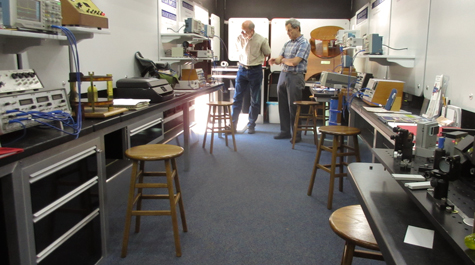Imagine a food truck, only full of physics experiments
Heard this one?
A guy walks up to the Food Truck for the Physics Mind and asks if fries come with the Schödinger’s Catfish.
“Well,” the proprietor says, “they do and they don’t.”
Carl Grossman is the actual proprietor of the Food Truck for the Physics Mind. He says he really does get the occasional visitor looking for a meal, but his job is serving up nourishment for science.
It’s the wrong place to go for Schödinger’s Catfish or even for Schödinger’s Cat, as the eponymous feline is part of a thought experiment, an imaginary scenario involving a decaying particle, a vial of poison and a cat. The Food Truck for the Physics Mind deals in actual experiments.
Grossman runs the innovative traveling outreach initiative by TeachSpin, a manufacturer of laboratory instruments designed for higher-education teaching. Grossman steers his Food Truck from college to university, welcoming physicists and physics students into a 44-foot-long chamber filled with instrumentation.
The Food Truck was visiting William & Mary on May 2, parked in the alleyway between the Muscarelle Museum and Phi Beta Kappa Memorial Hall. It was a strategic, well-trafficked spot near Small Hall, but Keith Griffioen told Grossman the date was unfortunate.
“It’s finals week,” said Griffioen, a professor in the university’s Department of Physics. “And our majors have to finish up their senior projects. They really don’t have any time.”
Even so, traffic was steady. A number of grad students and researchers filtered through, checking out more than a dozen experimental set-ups, condensed versions of what they work with in their own labs. Grossman pointed out that many of the instruments were built and/or selected to expose the needles, dials and wires, as compared to the wholly contained “black box” type instruments common in working labs.
Grossman said his instrumentation stock includes apparatus appropriate for beginning physics students up through early graduate school.
“We have a little bit of a specialty in nuclear magnetic resonance physics —NMR, a widely used tool in chemistry, biology,” Grossman said. “It’s the basis for how MRI imaging works.”
He showed off a selection of NMR instruments, beginning with an earth-field NMR, which measures the geomagnetic field of the earth at a frequency of around 2 kilohertz.
“And compare that to the big NMR magnet we have over there in Small,” Griffioen added. “17.6 Tesla,” or 750 megahertz.
Grossman’s gig requires a singular set of qualifications. There probably aren’t many physicist-truckers in the United States. He said he failed the road test for the commercial driving license twice.
“I’m not a driver of large vehicles. I rode my bike around most of the time. I have a small car. Getting used to this thing is quite challenging,” he said. “I failed on the parallel parking . You have to parallel park a full 18 wheeler. In traffic. And not hit a curb. Let’s not talk about it.” Skip to main content
Skip to main content

